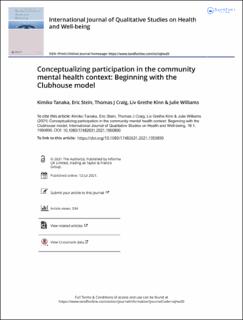| dc.contributor.author | Tanaka, Kimiko | |
| dc.contributor.author | Stern, Eric | |
| dc.contributor.author | Craig, Thomas | |
| dc.contributor.author | Kinn, Liv Grethe | |
| dc.contributor.author | Williams, Julie | |
| dc.date.accessioned | 2021-10-21T13:49:31Z | |
| dc.date.available | 2021-10-21T13:49:31Z | |
| dc.date.created | 2021-09-10T14:03:34Z | |
| dc.date.issued | 2021 | |
| dc.identifier.citation | Tanaka, K., Stein, E., Craig, T. J., Kinn, L. G., & Williams, J. (2021). Conceptualizing participation in the community mental health context: Beginning with the Clubhouse model. International Journal of Qualitative Studies on Health and Well-being, 16(1). | en_US |
| dc.identifier.issn | 1748-2623 | |
| dc.identifier.uri | https://hdl.handle.net/11250/2824570 | |
| dc.description.abstract | Purpose
Although participation is key to community mental health, the concept remains elusive. The study explored a conceptualization of participation in the community-based mental health agencies context from a first-person perspective, using the Clubhouse model as an example.
Methods
Qualitative data, collected from 21 Clubhouse service users through three focus groups (1 UK and 2 US) for primary analysis and secondary data from 104 individual interviews, were analysed using a grounded theory approach.
Results
Focus group narratives revealed three main domains of what may be named everyday participation process, Making Decisions, Doing Work, and Locating Oneself in Community, blended with each other rather than forming clear-cut stages. Sixty-six extracted primary codes, with two underlying interrelated core categories identified, named Autonomy and Egalitarian Connection, were organized by domain and by category.
Conclusions
The findings suggest a 3 × 2 axial model of participation that participation signifies a behaviour, comprised of three blended activity domains, entailing actions and interactions that concern Autonomy and Egalitarian Connection, which, dynamically interacting with each other, appear to condition meaningful participation the next day. Egalitarian relationship skills development appears critical for training practitioners to help promote service users’ quality everyday participation and getting-a-life-back experiences towards well-being, or meaningful life. | en_US |
| dc.language.iso | eng | en_US |
| dc.publisher | Taylor & Francis | en_US |
| dc.rights | Navngivelse 4.0 Internasjonal | * |
| dc.rights.uri | http://creativecommons.org/licenses/by/4.0/deed.no | * |
| dc.subject | conceptualization | en_US |
| dc.subject | participation | en_US |
| dc.subject | community mental health | en_US |
| dc.subject | Clubhouse | en_US |
| dc.subject | decision-making | en_US |
| dc.subject | work activity | en_US |
| dc.subject | community | en_US |
| dc.subject | autonomy | en_US |
| dc.subject | egalitarian connection | en_US |
| dc.subject | well-being | en_US |
| dc.title | Conceptualizing participation in the community mental health context: Beginning with the Clubhouse model | en_US |
| dc.type | Peer reviewed | en_US |
| dc.type | Journal article | en_US |
| dc.description.version | publishedVersion | en_US |
| dc.rights.holder | © 2021 The Author(s) | en_US |
| dc.source.pagenumber | 15 | en_US |
| dc.source.volume | 16 | en_US |
| dc.source.journal | International Journal of Qualitative Studies on Health and Well-being | en_US |
| dc.source.issue | 1 | en_US |
| dc.identifier.doi | 10.1080/17482631.2021.1950890 | |
| dc.identifier.cristin | 1933300 | |
| dc.relation.project | JSPS KAKENHI: JP 19K02196 | en_US |
| cristin.ispublished | true | |
| cristin.fulltext | original | |
| cristin.qualitycode | 1 | |

